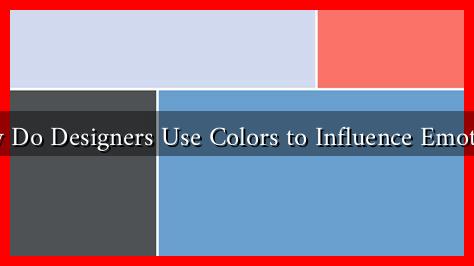-
Table of Contents
How Do Designers Use Colors to Influence Emotions?
Color is a powerful tool in the hands of designers, capable of evoking emotions, influencing perceptions, and even driving consumer behavior. From branding to interior design, the strategic use of color can significantly impact how a message is received. This article explores the psychology of color, how designers leverage it to influence emotions, and the implications for various industries.
The Psychology of Color
Color psychology is the study of how colors affect human behavior and emotions. Different colors can evoke different feelings and associations, which designers can harness to create specific emotional responses. Here are some common associations:
- Red: Often associated with passion, energy, and urgency. It can stimulate appetite, which is why many restaurants use red in their branding.
- Blue: Conveys trust, calmness, and professionalism. Many corporate brands, like Facebook and IBM, use blue to instill confidence.
- Green: Represents nature, health, and tranquility. It is frequently used in eco-friendly brands to emphasize sustainability.
- Yellow: Evokes feelings of happiness and optimism but can also be overwhelming in large doses. Brands like McDonald’s use yellow to attract attention.
- Purple: Associated with luxury, creativity, and wisdom. It is often used in beauty and high-end products.
Case Studies: Color in Action
To understand how color influences emotions, let’s look at some real-world examples:
1. Coca-Cola
Coca-Cola’s iconic red and white branding is designed to evoke feelings of excitement and happiness. The color red stimulates appetite and encourages impulsive buying, making it an effective choice for a beverage company. According to a study by the Institute of Color Research, people make a subconscious judgment about a product within 90 seconds of initial viewing, and 62-90% of that assessment is based on color alone.
2. Airbnb
Airbnb uses a warm coral color in its branding, which conveys friendliness and approachability. This choice helps to create a welcoming atmosphere, encouraging users to feel comfortable when booking accommodations. The emotional response elicited by the color choice aligns with Airbnb’s mission to foster connections between hosts and guests.
Color in Interior Design
In interior design, color can dramatically alter the mood of a space. Designers often use color schemes to create specific atmospheres:
- Warm Colors: Reds, oranges, and yellows can make a space feel cozy and inviting but can also be energizing.
- Cool Colors: Blues, greens, and purples tend to create a calm and serene environment, ideal for bedrooms and relaxation areas.
- Neutral Colors: Whites, grays, and beiges provide a versatile backdrop that can make spaces feel larger and more open.
For instance, a study by the University of Texas found that people in blue rooms reported feeling more relaxed than those in red rooms, highlighting the emotional impact of color in living spaces.
The Impact of Color in Marketing
Color also plays a crucial role in marketing and advertising. Research indicates that color can increase brand recognition by up to 80%. Here are some ways designers use color in marketing:
- Brand Identity: Consistent use of color helps establish a brand’s identity and makes it more memorable.
- Call to Action: Bright colors like orange or green are often used for buttons and calls to action to draw attention and encourage clicks.
- Target Audience: Different demographics may respond differently to colors, so understanding the target audience is essential for effective design.
Conclusion
Designers wield the power of color to influence emotions and behaviors in profound ways. By understanding the psychology of color and its implications in branding, interior design, and marketing, designers can create more effective and emotionally resonant experiences. As we continue to navigate a visually driven world, the strategic use of color will remain a vital component of design practice.
For further reading on color psychology and its applications, you can explore resources like Color Psychology.

